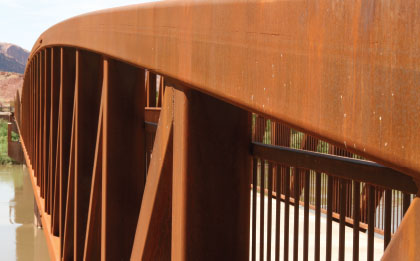Part 1: Understanding the material and choosing filler metals for the job
When corrosion caused by rain, snow, humidity, etc.—commonly referred to as atmospheric corrosion—is of concern in a welding application, weathering steels are often a viable option for the job. These materials feature additions of copper, nickel, and chromium that help improve the atmospheric corrosion resistance of the steel. As a result, weathering steel structures are often left largely unpainted, reducing or eliminating a source of added time and cost. Because many of these materials also provide good mechanical properties, weathering steels are commonly used for bridges and other load-bearing structures.
Weathering steels do not prevent rusting, but rather change the way that it occurs so that it can be used beneficially. In essence, the alloys in weathering steels make the rust/oxide layer (known as a patina) form quicker and thicker, and also make it more difficult to remove by rain, wind, or light abrasion than the rust of non-weathering grade steels. The patina acts like a natural, durable layer of paint that prevents the exposure of unreacted iron—found in the underlying base material—to the atmosphere. The result is a fabricated structure that is more resistant to losing material thickness, and also load carrying capacity, caused by the elements.
Sculptors and architects may also choose to use weathering steels simply for aesthetics. The texture and colors of the patina provides the unique appearance and character of a structure with significant age in significantly less time.
Common weathering steel specifications used in structural fabrication include ASTM A242, A588, A606, and A847. Specifications common to bridge fabrication include ASTM A709 and AASHTO M270. Several manufacturers also use trade names to indicate their unique patented formulations of weathering steel, such as U.S. Steel’s COR-TEN®.
CHOOSING THE FILLER METAL
When choosing the appropriate filler metal for welding weathering steels, there are numerous factors to consider:
- The code or specification requirements that exist
- The strength and toughness level required
- Where the weld will be located and if it will be painted
- The joint geometry and required weld size
- If “color match” is desired
Alongside design requirements, welding codes and specifications provide unbreakable rules contractors must abide by during welding and fabrication that override all other technical advice. The two most common steel welding codes, American Welding Society (AWS) D1.1 and D1.5, which respectively govern structural and bridge welding, directly address the use of weathering steels and provide welding methods appropriate to different service environments for these materials.
Weathering steels are available in a wide variety of yield strength levels—typically ranging from 50 to 100 ksi—and minimum toughness. However, filler metal requirements vary by application. Matching the mechanical properties of the filler metal—the tensile strength, yield strength, and toughness—to the design requirements is critical to ensuring the intended performance of the structure. It is common practice for the filler metal to at least meet the minimum mechanical properties of the base material, but design requirements may require or allow under-matching or over-matching in certain instances. Always confirm the exact specification and grade of material being welded, and all design requirements prior to selecting a filler metal.
Two other important considerations when selecting a filler metal are if the weld will be located away from sources of atmospheric corrosion and whether it will be painted. Welds in a less exposed area, and particularly those that will be painted over, may not require a corrosion resistant filler metal like welds left unpainted and exposed to atmospheric elements.
When choosing a filler metal there are additional questions to consider as they relate to joint geometry and required weld size, relative to material mechanical properties.
- Does the base material have a minimum yield strength requirement of 50 ksi?
- Will the weld be completed in one pass, or one pass on each side of the weldment?
- If the weld is a fillet weld, will the leg sizes be less than or equal to 5/16 inch when
- using solid wire, metal-cored wire, or flux cored wires, or 1/4 inch when using stick electrodes?
CARBON STEEL FILLER METALS
Answering yes to the above questions indicates welds that are single pass, small, and on a lower strength grade of weathering steel, which means a low-cost carbon steel filler metal without significant alloying elements may be used, provided the product still meets minimum mechanical property requirements.
Welding small-size, single-pass welds typically causes a high amount of base metal dilution; a large amount of base metal is melted and mixed with the weld metal. As a result, the weld picks up a sizable amount of alloying elements from the weathering steel, which can provide the weld metal with the same atmospheric corrosion resistant properties as the base metal itself.
Some of the most common carbon steel filler metals suitable for small welds on low-strength weathering steels include AWS E7018 stick electrodes, ER70S-3/6 solid wires, E70C-6M metal-cored wire, and E71T-1/9 C/M flux-cored wires.
Part 2 of the article will appear in the next issue of MCS and will cover answering “no” to the questions regarding filler metal, the use of low alloy filler metals, and filler metals for color-matching applications.
■ ■ ■
[divider]
About The Author Robert Fox is a welding engineer in the applications engineering department of Hobart Brothers Company. For more information, visit www.hobartbrothers.com.


